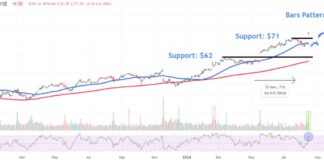The Dollar emerged as the clear winner in the currency markets last week, with both the Dollar Index and the 10-year US Treasury Yield breaking through significant resistance levels. This surge in the Dollar and Treasury Yield may be attributed to traders positioning themselves ahead of the upcoming US presidential election, which is less than two weeks away. However, the recent pullback in stock markets suggests that investors are exercising caution. The next two weeks will be crucial in determining medium-term trends in the markets.
On the other hand, the Japanese Yen experienced a prolonged selloff and ended the week as the worst-performing major currency. Verbal interventions by Japanese officials had limited impact due to ongoing political uncertainty surrounding the snap election. This uncertainty also led to significant declines in the Nikkei index. The weakness of the Yen was mirrored by the New Zealand Dollar and Australian Dollar, both of which closed near the bottom of the performance chart.
In contrast, European currencies held their ground, with the Euro showing resilience despite discussions within the ECB about accelerating monetary easing measures. The Canadian Dollar and Swiss Franc were among the stronger currencies last week, although their strength was modest compared to the dominance of the US Dollar.
Investors are becoming increasingly cautious as the global markets brace for a crucial two weeks ahead, marked by the upcoming US non-farm payroll report and a closely contested US presidential election. The recent declines in the DOW and S&P 500, along with the record intraday high in the NASDAQ that didn’t hold, indicate an underlying cautious sentiment in the markets. The 10-year Treasury yield remains above 4.23% after a strong rally, supporting the Dollar as the best-performing currency among majors.
The non-farm payroll report next week is expected to shape the Fed’s anticipated easing cycle, with futures markets implying high probabilities of rate cuts in November and December. The outcome of the US presidential election could bring significant shifts to fiscal policy, bond issuance, and trade relations, adding uncertainty to the markets.
Technical analysis suggests that the S&P 500 and NASDAQ may see some consolidation in the near term, with potential bullish trends in the long term. The US 10-year yield and Dollar Index have broken through key resistance levels, indicating possible further bullish momentum in the future.
The Japanese Yen’s decoupling from the Nikkei index is attributed to heightened political uncertainty in Japan, with technical analysis suggesting a potential further decline in the Nikkei. The Euro found support from PMI data in the Eurozone amid intense ECB debates, with technical analysis indicating a possible near-term bullish reversal in EUR/AUD.
In the USD/CAD pair, the rally from 1.3418 continues, with resistance zones and support levels to watch for potential trend changes. The bigger picture suggests a sideways consolidation pattern with a possible uptrend resumption in the long term.
Overall, the next two weeks will be critical for the markets, with key economic data releases and the US presidential election shaping investor sentiment and market trends.

















